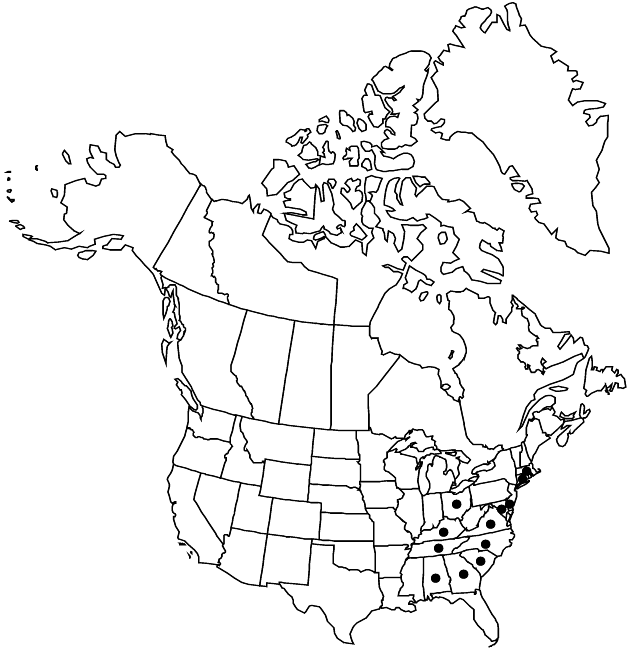Eurybia surculosa
Phytologia 77: 262. 1995.
Plants 10–90 cm; in clones and clumps (sometimes with rosettes), eglandular (except pedicels); rhizomes slender, herbaceous becoming woody, scaly. Stems 1–3+, erect, simple, straight, proximally sparsely strigillose to glabrescent, distally strigose or villoso or hirsuto-strigose. Leaves basal and cauline, firm (only midnerves conspicuous), margins slightly revolute, slightly indurate, entire or sometimes remotely crenulate-serrulate, scabrous, teeth indurate, apices acute to obtuse, indurate, often mucronate, abaxial faces scabrous, adaxial sparsely strigose or glabrous; basal and proximal cauline usually persistent, sometimes withering by flowering (bases often marcescent), petioles sometimes narrowly winged, bases sheathing, blades narrowly elliptic, narrowly ovate, or lanceolate to spatulate, narrowly obovate, or oblanceolate, 13–135 × (2–) 6–35 mm (earliest smaller), bases attenuate to cuneate; mid short-winged-petiolate or sessile, blades lance-oblong, lance-elliptic, lanceolate, or oblanceolate, 22–105 × 3–14 mm, gradually reduced distally, bases slightly auriculate-clasping to cuneate or attenuate; distal (arrays) sessile, blades lanceolate to linear, 7–42 × 1–6 mm, abruptly reduced. Heads (1–) 3–50 (–122+), usually in open or dense, corymbiform arrays, seldom borne singly. Peduncles densely strigose or strigoso-hispid, sometimes sparsely long-stipitate-glandular distally; bracts (0–) 1–3 (–6), leaflike to phyllary-like (bases indurate), scabrous or sparsely strigose. Involucres cylindro-campanulate, 7–11 (–13) mm, shorter than pappi. Phyllaries 35–65 in 4–5 series, oblong (outer) to linear-oblong or seldom linear (inner), strongly unequal, membranous, bases indurate, rounded (outer), dark green zones foliaceous, sometimes slightly dilated, in distal 1/3–1/2 (outer) to 1/8–1/7 or none and not reaching margins (inner), margins hyaline or sometimes purplish, narrowly scarious, erose, ciliate (scarious parts), ± scabrous (foliaceous parts), sometimes short-stipitate-glandular (innermost), apices spreading to squarrose, obtuse, often dilated (innermost), mucronulate (outer) or apiculate (inner), abaxial faces glabrous or strigillose, both scabrellous on foliaceous parts. Ray-florets 13–30; corollas bluish violet, (8–) 11.5–15.5 × 1.5–2.3 mm. Disc-florets 25–40; corollas pale-yellow turning purplish, 5–7.2 mm, slightly ampliate, tubes shorter than funnelform throats, lobes erect, deltate to triangular, 0.75–1.1 mm. Cypselae brown, cylindro-obconic, slightly compressed, 3.2–3.5 mm, ribs 8–10, stramineous, strigillose; pappi of tawny-yellowish to pinkish bristles 5.2–7.1 mm, ± equaling disc corollas. 2n = 36.
Phenology: Flowering summer–fall.
Habitat: Dry to wet, especially sandy soils, open, pinelands, oak-scrub, clearings, bogs, roadsides
Elevation: 200–1500 m
Distribution

Ala., Conn., Del., Ga., Ky., Md., Mass., N.C., Ohio, S.C., Tenn., Va.
Discussion
Eurybia surculosa is of conservation concern in Virginia and Alabama. It is often confused with E. compacta, its close relative from the coastal plains. In states where both are present, it is found only inland in the southern Appalachian Mountains and not on the coastal plains; its larger heads help to differentiate it from E. compacta.
Selected References
None.
Lower Taxa
"[" is not declared as a valid unit of measurement for this property."]" is not declared as a valid unit of measurement for this property.